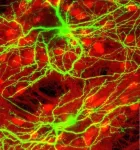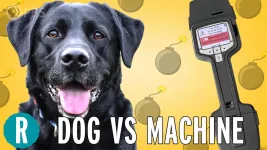The astonishing self-organization skills of the brain
Uncovering how neural circuits achieve a balance between excitation and inhibition
2021-03-22
(Press-News.org) A team of researchers from Tübingen and Israel uncovers how brain structures can maintain function and stable dynamics even in unusual conditions. Their results might lay the foundations for better understanding and treating conditions like epilepsy and autism.
The neurons in our brains are connected with each other, forming small functional units called neural circuits. A neuron that is connected to another one via a synapsis can transmit information to the second neuron by sending a signal. This, in turn, might prompt the second neuron to transmit a signal to other neurons in the neural circuit. If that happens, the first neuron is likely an excitatory neuron: one that prompts other neurons to fire. But neurons with the exact opposite task are equally important to the functionality of our brain: inhibitory neurons, which make it less likely that the neurons they are connected to send a signal to others.
The interplay of excitation and inhibition is crucial for normal functionality of neural networks. Its dysregulation has been linked to many neurological and psychiatric disorders, including epilepsy, Alzheimer's disease, and autism spectrum disorders.
From cell cultures in the lab...
Interestingly, the share of inhibitory neurons among all neurons in various brain structures (like the neocortex or the hippocampus) remains fixed throughout the lifetime of an individual at 15 to 30 percent. "This prompted our curiosity: how important is this particular proportion?", recalls Anna Levina, a researcher at Tübingen University and the Max Planck Institute for Biological Cybernetics. "Can neural circuits with a different proportion of excitatory and inhibitory neurons still function normally?" Her collaborators from the Weizmann Institute of Science in Rehovot (Israel) designed a novel experiment that would allow to answer these questions. They grew cultures that contained different, even extreme ratios of excitatory and inhibitory neurons.
The scientists then measured the activity of these artificially designed brain tissues. "We were surprised that networks with various ratios of excitatory and inhibitory neurons remained active, even when these ratios were very far from natural conditions", explains Levina's PhD student Oleg Vinogradov. "Their activity does not change dramatically, as long as the share of inhibitory neurons stays somewhere in the range of 10 to 90 percent." It seems that the neural structures have a way of compensating for their unusual composition to remain stable and functional.
...to a theoretical understanding
So naturally the researchers asked next: what mechanism allow the brain tissue to adjust to these different conditions? The researchers theorized that the networks adapt by adjusting the number of connections: If there few inhibitory neurons, they have to take on a bigger role by building more synapses with the other neurons. Conversely, if the share of inhibitory neurons is large, the excitatory neurons have to make up for this by establishing more connections.
The theoretical model of the Tübingen scientists can explain the experimental findings of their colleagues in Rehovot and uncover the mechanisms helping to maintain stable dynamics in the brain. The results provide a clearer picture of how excitation/inhibition balance is preserved and where it fails in living neural networks. In the longer term, they might be useful for the emergent field of precision medicine: induced pluripotent stem cell derived neural cultures could be used to find mechanisms of neuropsychiatric disorders and novel medications.
INFORMATION:
Original publication
Nirit Sukenik, Oleg Vinogradov, Eyal Weinreb, Menahem Segal, Anna Levina, Elisha Moses
Neuronal circuits overcome imbalance in excitation and inhibition by adjusting connection numbers
PNAS 2021, Vol. 118
[Attachments] See images for this press release:

ELSE PRESS RELEASES FROM THIS DATE:
2021-03-22
Tsukuba, Japan - An earthquake is generally viewed to be caused by a rupture along a fault that is transmitted outward from its point of origin in a uniform, predictable pattern. Of course, given the complexity of the environments where these ruptures typically occur, the reality is often much more complicated.
In a new study published in Scientific Reports, a research team led by the University of Tsukuba developed a new method to model the details of complex earthquake rupture processes affecting systems of multiple faults. They then applied this method to the magnitude ...
2021-03-22
An international team of interdisciplinary researchers has identified mathematical metrics to characterize the fragility of financial markets. Their paper "Network geometry and market instability" sheds light on the higher-order architecture of financial systems and allows analysts to identify systemic risks like market bubbles or crashes.
With the recent rush of small investors into so-called meme stocks and reemerging interest in cryptocurrencies talk of market instability, rising volatility, and bursting bubbles is surging. However, "traditional economic theories cannot foresee events like the US subprime mortgage collapse of 2007" according ...
2021-03-22
Point
Epithelial cell rests of Malassez derived from the periodontal ligament were transformed into progenitor stem-like cells by stimulation with epigenetic agents.
Subsequently, the progenitor stem-like cells were directly differentiated into endothelial, mesenchymal stem, and osteogenic cells that constitute the periodontal ligament.
Background
Stem cells derived from the dental pulp or periodontal ligament have been used for regenerative dentistry. Although it is relatively easy to collect the dental pulp stem cells, it is difficult to obtain adequate numbers of good quality cells; a ...
2021-03-22
Using an improved version of the gene editing tool CRISPR/Cas9, researchers knocked out up to twelve genes in plants in a single blow. Until now, this had only been possible for single or small groups of genes. The approach was developed by researchers at Martin Luther University Halle-Wittenberg (MLU) and the Leibniz Institute of Plant Biochemistry (IPB). The method makes it easier to investigate the interaction of various genes. The study appeared in The Plant Journal.
The inheritance of traits in plants is rarely as simple and straightforward as Gregor Mendel described. The monk, whose experiments in the 19th century on trait inheritance in peas laid the foundation of genetics, in fact got lucky. "In the traits that ...
2021-03-22
Patricia Bernal, a Ramón y Cajal researcher at the Department of Microbiology of the University of Seville's Faculty of Biology, is working with the bacterium Pseudomonas putida, a biological control agent found in the soil and in plant roots and which, as such, has the ability to protect plants from pathogen attacks (organisms that cause diseases) also known as phytopathogens. Specifically, the US researcher is studying a molecular weapon that bacteria use (Type VI Secretion System or T6SS) to eliminate their competitors.
The T6SS could be compared to a harpoon with a poisonous tip that bacteria throw at their enemies to annihilate them. In a recent paper, which has just been published in the scientific journal PNAS and for ...
2021-03-22
Igor Stagljar made his career building molecular tools to combat cancer. But when the pandemic hit last March, he aimed his expertise at a new adversary, SARS-CoV-2.
Stagljar is a professor of biochemistry and molecular genetics in the Donnelly Centre for Cellular and Biomolecular Research at U of T's Temerty Faculty of Medicine. Last spring, with support from U of T's Toronto COVID-19 Action Fund, his team began developing a new method for measuring immunity to coronavirus in those who recovered from COVID-19.
They are now ready to reveal their creation -- a pinprick test that accurately measures ...
2021-03-22
"You have to win the battle against depression", "what counts is not surrendering" and "this is not a short road" are examples of conceptual metaphors typically used to describe experiences and issues associated with disorders like depression. Such expressions allude to abstract concepts but do so using familiar terms that enable better understanding of the experience. This kind of metaphor is often used unconsciously, going unnoticed by both speaker and listener. However, the study of metaphors can help access and understand the thinking, beliefs and feelings of individuals with mental disorders.
The conceptual metaphors of depression found in 23 blogs written by people with major depressive disorders were analysed by a multidisciplinary UOC team composed of Marta Coll-Florit and Salvador ...
2021-03-22
The results argue for a comprehensive approach to disease prevention. The scientists have now published their findings in the journal Nature Medicine.
Many elderly people suffer simultaneously from several, frequently very different diseases, a condition also known as multimorbidity. Their quality of life is severely restricted, and they receive medication from different doctors, a process which is difficult and often insufficiently coordinated. Observations indicate that certain diseases commonly occur together, but the causes of this are largely ...
2021-03-22
It's well known that mentoring opportunities are critical for development and career advancement, and are associated with greater job satisfaction and increased earnings and promotions.
Yet a recent study co-authored by RMIT University's Professor Andrew R. Timming found women may be missing out on these opportunities due to fears by male managers of potential misconduct allegations.
"Workplace relations between males and females have changed over the past two years. Male managers are significantly less likely than female managers to mentor or interact one-on-one with female employees," Timming said.
"We found that male managers were less likely to work one-on-one in an office with the door closed and less likely to have ...
2021-03-22
WASHINGTON, March 22, 2021 -- What's better at finding a hidden bomb -- a dog or an electronic chemical detector? In this episode, the Reactions team travels to the U.S. Naval Research Laboratory to find out: https://youtu.be/TRwqOFHOjac.
INFORMATION:
Reactions is a video series produced by the American Chemical Society and PBS Digital Studios. Subscribe to Reactions at http://bit.ly/ACSReactions and follow us on Twitter @ACSReactions.
The American Chemical Society (ACS) is a nonprofit organization chartered by the U.S. Congress. ACS' mission is to advance the broader ...
LAST 30 PRESS RELEASES:
[Press-News.org] The astonishing self-organization skills of the brain
Uncovering how neural circuits achieve a balance between excitation and inhibition






